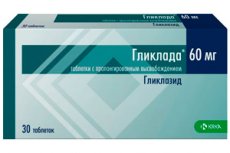Glyclada
最近審查:04.07.2025

格列齐特(Gliclada)含有格列齐特,是第二代口服降糖药,属于磺酰脲类衍生物,用于治疗非胰岛素依赖型糖尿病(2型)。格列齐特可改善胰岛素分泌,并可能有助于降低此类糖尿病患者的胰岛素抵抗。格列齐特的疗效包括降低血糖水平,且短期和长期使用均能维持疗效,其效果与其他磺酰脲类药物相当。
尤其值得注意的是,格列齐特可能因其血液生物学作用而对糖尿病视网膜病变患者有益,并且在胰岛素治疗中添加格列齐特可以减少胰岛素剂量。因此,格列齐特可有效纠正与非胰岛素依赖型糖尿病相关的代谢异常,并可能具有减缓糖尿病视网膜病变进展的额外益处。这些特性,加上良好的耐受性和较低的低血糖发生率,使格列齐特在控制非胰岛素依赖型糖尿病的口服降糖药中占据重要地位 (Palmer & Brogden, 1993)。
適應症 Glyclades
Glyclada 用于治疗 2 型糖尿病。当饮食、运动和生活方式的改变不足以有效控制血糖水平时,可以使用这种药物。根据患者的具体情况,它可以单独使用,也可以与其他抗糖尿病药物(例如二甲双胍或胰岛素)联合使用。
發布表單
Glyclada 通常以口服片剂形式提供。
藥效學
作用机制:
- Glyclada 通过刺激胰腺 β 细胞释放胰岛素发挥作用。
- 它还能增加组织对胰岛素的敏感性,从而改善身体对葡萄糖的利用并降低血糖水平。
- 值得注意的是,Gliclada 在正确剂量下使用时通常不会引起低血糖,这使其成为糖尿病患者的首选血糖控制剂。
藥代動力學
- 吸收:格列齐特口服后一般经胃肠道吸收良好,通常在服药后1-4小时达到血药峰浓度。
- 代谢:格列齐特吸收后在肝脏代谢,主要代谢产物为格列齐特的活性形式,具有降血糖作用。
- 排泄:格列齐特主要以代谢物形式经尿液排出。肾功能正常的患者,格列齐特的消除半衰期约为8-12小时。
- 肝脏:由于格列齐特在肝脏中代谢,肝功能受损的患者可能需要调整剂量。
- 肾脏:由于格列齐特通过尿液排泄,肾功能不全的患者可能需要调整剂量。
- 作用时间:格列齐特的作用时间约为12-24小时,每天可服用一次或两次。
劑量和管理
使用方法:
- Glyclada 通常在饭前口服。
- 应使用少量水将药片整片吞服。
- 建议每天在同一时间服用药片,以确保血液中的药物水平稳定。
剂量:
- Glyclada 的剂量由医生根据患者的个人需求和疾病的严重程度决定。
- 成人的通常起始推荐剂量为每天服用 30 毫克一次。
- 根据治疗反应和医生的建议,剂量可以增加到每天 60 或 120 毫克。
入院时长:
- 服用 Glyclada 的持续时间由医生决定,取决于糖尿病的性质和严重程度。
- 该药物通常需要长期服用才能维持稳定的血糖水平。
在懷孕期間使用 Glyclades
由于格列齐特(Gliclad)对胎儿的安全性数据有限,不建议在妊娠期间使用。现有研究表明,与二甲双胍相比,妊娠期间使用格列齐特不会增加产妇住院风险或新生儿不良结局,然而,研究的妊娠数量有限,这是一个关键的局限性(Kelty 等人,2020 年)。
在另一个案例中,尽管在前 16 周接触格列齐特和雷米普利后妊娠结果正常,但需要注意的是,这并不能为这些药物在妊娠期间的安全性提供明确证据,特别是考虑到已知的与雷米普利等 ACE 抑制剂相关的风险(Kolağası 等人,2009 年)。
因此,怀孕期间应避免使用格列齐特,尤其是在未仔细咨询可以评估其使用潜在风险和益处的医生的情况下。
禁忌
- 过敏症:已知对格列齐特或该药物的任何成分过敏的人不应服用 Gliclada。
- 1 型糖尿病:不建议使用格列齐特治疗以胰岛素绝对缺乏为特征的 1 型糖尿病。
- 抗糖尿病药物:服用某些抗糖尿病药物或胰岛素的患者可能禁用格列齐特,尤其是如果这可能导致低血糖。
- 肝功能不全:对于严重肝功能不全的患者,应谨慎并在医疗监督下使用 Glyclada,因为药物代谢的变化可能需要调整剂量。
- 怀孕和哺乳:关于格列齐特在怀孕和哺乳期间的安全性的信息有限,因此在此期间使用格列齐特应仅在医生的建议下进行。
- 儿科人群:Glyclada 对儿童的疗效和安全性尚未确定,因此儿童使用时可能需要咨询医生。
- 老年人:对于老年患者,使用格列齐特时可能需要更谨慎地开处方和定期监测。
副作用 Glyclades
- 低血糖症(低血糖),尤其是当您不遵循饮食或与其他抗糖尿病药物一起服用时。
- 皮肤对阳光不耐受(光敏感)。
- 服用高剂量药物时血糖水平升高(高血糖症)。
- 胃肠道疾病,如恶心、呕吐、腹泻、便秘。
- 头痛、疲劳、嗜睡。
- 肝酶水平升高。
- 罕见的是,可能会出现过敏反应,包括皮疹、瘙痒或血管性水肿。
過量
- 头痛、头晕。
- 心律不齐或心悸。
- 呼吸不规律或呼吸困难。
- 虚弱、嗜睡或疲劳。
- 焦虑、紧张或烦躁。
- 饥饿或颤抖。
- 失去意识或昏迷。
與其他藥物的相互作用
- 增强降血糖作用的药物:降低血糖水平的药物(例如胰岛素或其他降血糖药)可能会增强格列齐特的降血糖作用。这可能导致低血糖症(低血糖),需要密切监测血糖水平。
- 升高血糖水平的药物:某些药物,例如糖皮质激素(例如泼尼松)或某些利尿剂(例如噻嗪类利尿剂),可能会升高血糖水平。这可能会降低Glyclada的疗效,并需要调整其剂量。
- 影响肝脏的药物:由于 Glyclada 在肝脏代谢,影响肝功能的药物(例如肝酶抑制剂或诱导剂)可能会改变其药代动力学。因此,肝功能障碍患者可能需要调整 Glyclada 的剂量。
- 酒精:服用格列齐特期间饮酒可能会增加低血糖的风险。这是因为酒精可能会增强格列齐特的降血糖作用。
- 影响肾功能的药物:由于 Glyclada 会通过尿液排泄,因此影响肾功能的药物(例如利尿剂或肾毒性药物)可能会改变其药代动力学并需要调整剂量。
注意!
為了簡化對信息的理解,本指令使用了藥物 "Glyclada",並根據藥物的醫療用途官方說明。 使用前請閱讀直接用於藥物的註釋。
描述僅供參考,不適用於自我修復指導。 這種藥物的需求,治療方案的目的,藥物的方法和劑量僅由主治醫師確定。 自我藥療對你的健康有危害。


